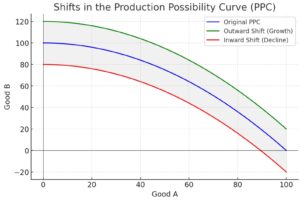Shifts in the Production Possibility Curve (PPC) occur when an economy’s capacity to produce goods and services changes. These shifts reflect changes in resource availability, technology, or other economic factors, indicating economic growth or decline. When the PPC shifts outward, it signifies an increase in the economy’s production capacity, usually due to advancements in technology, an increase in available resources, or improvements in the efficiency of production processes. This outward shift represents economic growth, as the economy can now produce more goods and services than before.
Conversely, an inward shift of the PPC indicates a decrease in the economy’s production capacity. This can result from factors such as a reduction in available resources, natural disasters, or a decline in technological capabilities. An inward shift represents economic decline, as the economy can now produce fewer goods and services than before.
Understanding shifts in the PPC is crucial for analyzing economic performance and making informed policy decisions. It helps economists and policymakers identify the factors driving economic growth or decline and develop strategies to enhance economic efficiency and productivity. Overall, the PPC serves as a valuable tool for assessing an economy’s potential and the impact of various changes on its productive capacity.
1. What Are Shifts in the Production Possibility Curve?
A shift in the PPC occurs when the entire curve moves outward or inward, representing a change in the economy’s productive capacity. An outward shift indicates economic growth, while an inward shift signifies a reduction in productive capacity.

A. Outward Shift of the PPC
- Definition: Represents an increase in an economy’s ability to produce goods and services.
- Illustration: The curve moves away from the origin, indicating higher potential output.
B. Inward Shift of the PPC
- Definition: Represents a decrease in an economy’s productive capacity.
- Illustration: The curve moves towards the origin, indicating reduced potential output.
2. Causes of Shifts in the PPC
A. Outward Shifts
- Technological Advancements: Innovations increase efficiency and output.
- Increase in Resources: More labor, capital, or natural resources enhance production capacity.
- Improved Education and Training: Skilled workforce boosts productivity.
- Capital Investment: Investments in infrastructure and machinery expand production.
B. Inward Shifts
- Natural Disasters: Events like earthquakes or floods reduce resources.
- War and Conflicts: Destruction of infrastructure and resources limits production.
- Economic Recession: Reduced investment and employment lower productive capacity.
- Resource Depletion: Overuse of natural resources leads to scarcity.
3. Effects of Shifts in the PPC
A. Effects of Outward Shifts
- Economic Growth: Higher production potential leads to increased output and income.
- Higher Living Standards: More goods and services improve quality of life.
- Employment Opportunities: Expanding industries create more jobs.
B. Effects of Inward Shifts
- Economic Decline: Reduced production leads to lower output and income.
- Unemployment: Shrinking industries result in job losses.
- Lower Living Standards: Fewer goods and services reduce quality of life.
4. Examples of Shifts in the PPC
A. Historical Example of Outward Shift
- Industrial Revolution: Technological innovations in manufacturing and transportation expanded production capacity.
B. Historical Example of Inward Shift
- World War II: Destruction of infrastructure in many countries led to a temporary inward shift of the PPC.
5. PPC Shifts in Different Economic Sectors
A. Agriculture
- Outward Shift: Adoption of modern farming techniques and machinery.
- Inward Shift: Droughts or soil depletion reducing crop yields.
B. Manufacturing
- Outward Shift: Automation and robotics increasing production efficiency.
- Inward Shift: Factory shutdowns due to economic downturns.
C. Services
- Outward Shift: Digital transformation enhancing service delivery.
- Inward Shift: Labor shortages impacting service industries.
6. Applications of PPC Shifts in Economic Policy
A. Fiscal Policy
- Application: Government spending on infrastructure can shift the PPC outward.
B. Monetary Policy
- Application: Lower interest rates can encourage investment, leading to an outward shift.
C. Trade Policy
- Application: Free trade agreements can enhance resource availability and shift the PPC outward.
7. Limitations of the PPC Model
A. Simplified Assumptions
- Limitation: Assumes only two goods, which is unrealistic in a complex economy.
B. Static Framework
- Limitation: Does not account for dynamic changes over time.
C. Exclusion of External Factors
- Limitation: External influences like global markets are not considered.
8. Understanding Shifts in the Production Possibility Curve
Shifts in the Production Possibility Curve provide valuable insights into an economy’s growth or decline. Outward shifts indicate economic expansion through resource growth or technological advancements, while inward shifts signal resource depletion or economic setbacks. Understanding these shifts helps in analyzing economic performance, guiding policy decisions, and planning for sustainable development.